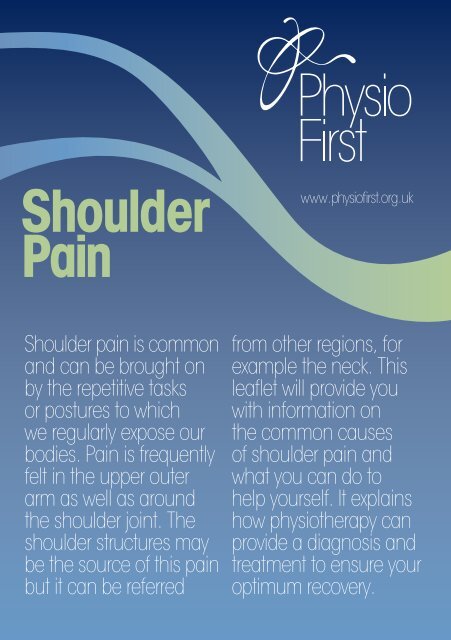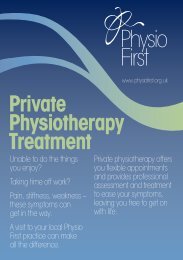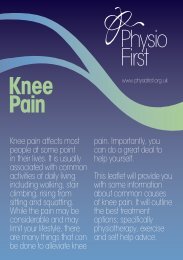Shoulder Pain Information Leaflet - Blairgowrie Physiotherapy
Shoulder Pain Information Leaflet - Blairgowrie Physiotherapy
Shoulder Pain Information Leaflet - Blairgowrie Physiotherapy
You also want an ePaper? Increase the reach of your titles
YUMPU automatically turns print PDFs into web optimized ePapers that Google loves.
<strong>Shoulder</strong><br />
<strong>Pain</strong><br />
www.physiofirst.org.uk<br />
<strong>Shoulder</strong> pain is common<br />
and can be brought on<br />
by the repetitive tasks<br />
or postures to which<br />
we regularly expose our<br />
bodies. <strong>Pain</strong> is frequently<br />
felt in the upper outer<br />
arm as well as around<br />
the shoulder joint. The<br />
shoulder structures may<br />
be the source of this pain<br />
but it can be referred<br />
from other regions, for<br />
example the neck. This<br />
leaflet will provide you<br />
with information on<br />
the common causes<br />
of shoulder pain and<br />
what you can do to<br />
help yourself. It explains<br />
how physiotherapy can<br />
provide a diagnosis and<br />
treatment to ensure your<br />
optimum recovery.
Physio First works through<br />
helping, teaching and guiding<br />
you, to help yourself to health.<br />
Important<br />
Most shoulder pain is not serious and does not require x-rays<br />
or scans to diagnose the cause. Conditions requiring further<br />
medical attention can present as shoulder pain therefore you<br />
should seek medical advice if you:<br />
— Suffered a significant trauma, particularly if the<br />
shoulder contour has changed and /or you have<br />
severe loss of movement or weakness<br />
— Have a history of cancer or cardiac problems<br />
— Feel generally unwell, develop a fever<br />
— Have swelling, redness or a rash over the area<br />
— Have constant pain not affected by<br />
movement of the shoulder.<br />
Common causes<br />
of shoulder pain<br />
<strong>Shoulder</strong> tendons<br />
The tendons around the<br />
shoulder joint blend to form<br />
a supportive cuff called the rotator<br />
cuff. Wear and tear<br />
of these tendons is called<br />
tendinosis, this is the most<br />
common cause of shoulder<br />
pain in the over 40’s.<br />
The tendons can be damaged<br />
by prolonged repetitive tasks<br />
or postures for example, using<br />
the computer, playing sports<br />
and performing DIY.<br />
<strong>Pain</strong> is felt with specific movements,<br />
like reaching back, reaching<br />
out to lift something or half<br />
way through reaching up or<br />
lowering the arm down. The<br />
term impingement may be<br />
used to describe these painful<br />
movements. This happens when<br />
the damaged tendons or<br />
inflamed bursa are compressed<br />
under the bone at the tip of the<br />
shoulder (the acromion).<br />
Occasionally, in the older<br />
population ongoing tendinosis<br />
may lead to a tear of the<br />
rotator cuff, resulting in<br />
marked weakness of certain<br />
shoulder movements.<br />
Bursitis<br />
Bursas are found around the<br />
body; these fluid filled sacks<br />
protect structures from rubbing<br />
on the surrounding bone. The<br />
large shoulder bursa, like the<br />
shoulder tendons can be irritated<br />
by repetitive tasks and causes<br />
impingement. When the bursa<br />
becomes inflamed, sleeping on<br />
that side becomes difficult,<br />
movements are limited and in<br />
severe cases the arm will ache<br />
even when resting at your side.
Physio First works through<br />
helping, teaching and guiding<br />
you, to help yourself to health.<br />
Frozen shoulder<br />
The capsule of the shoulder<br />
can become contracted and<br />
thickened often with no history of<br />
trauma or injury. The reason for<br />
this is still not fully understood but<br />
it is more common in diabetics,<br />
after shoulder or breast surgery<br />
and in women aged 40–60. The<br />
shoulder becomes increasingly<br />
painful and restricted, both when<br />
you lift it and when lifted for you.<br />
It follows 3 main stages:<br />
<strong>Pain</strong>ful phase – increasing pain<br />
Frozen stage – increasing stiffness,<br />
pain lessening eventually<br />
Thawing phase – stiffness reducing<br />
These phases last in total from<br />
18–24 months. Most people<br />
make a full recovery.<br />
Arthritis<br />
Arthritis can develop in the joint<br />
where the collar bone meets the<br />
shoulder blade, on the top of the<br />
shoulder – the acromioclavicular<br />
joint. It is common in middle<br />
age and results in a bony lump<br />
visible over the joint. It may result<br />
in a reduction of and ache at the<br />
end of your reaching movements.<br />
It can also provoke impingement<br />
in the tissues under the joint<br />
as described above. Other<br />
forms of arthritis can affect the<br />
ball and socket joint but this is<br />
relatively uncommon.<br />
Referred pain<br />
This describes pain coming from<br />
structures outside the painful area.<br />
The joints, nerves, muscles and<br />
ligaments in the neck can refer<br />
pain to the shoulder area. Nerve<br />
pain can make your arm and<br />
shoulder blade achy and heavy;<br />
pins and needles can develop in<br />
your arm and hand. Muscle pain<br />
as a result of tension, stress and<br />
repetitive tasks or postures can<br />
lead to pain and stiffness in the<br />
shoulder.<br />
<strong>Shoulder</strong> pain has many causes;<br />
assessment by a Physiotherapist<br />
will provide you with the correct<br />
diagnosis.<br />
What can I do to help?<br />
— If you need them, take the over-the-counter<br />
painkillers that work for you. Relieving some of the<br />
pain will allow you to relax muscles and keep the<br />
shoulder moving<br />
— Try to keep your arm moving within the limits<br />
of pain but do not overstretch. Gentle movement<br />
is important<br />
— Heat or cold can give you short term relief and<br />
relax muscle tension. Ask your Physiotherapist for<br />
advice on how and where to apply<br />
— Stress and anxiety can lead to muscle tension<br />
and pain. Try to sit in a supported position and<br />
“let go” while breathing out<br />
— In the early stages try to avoid any irritating<br />
movements or postures you have identified<br />
during your normal daily activities, sport or work.<br />
Seek advice from your Physiotherapist on how<br />
and when to return to these tasks<br />
— Contact your local Physiotherapist. The correct<br />
diagnosis can reduce your anxiety and direct you<br />
to the most effective treatment.
Physio First works through<br />
helping, teaching and guiding<br />
you, to help yourself to health.<br />
How can physiotherapy help?<br />
Remember<br />
Your Physiotherapist will be able to identify the source of your shoulder<br />
pain and explain the reasons why you have developed the symptoms.<br />
Physiotherapists are experts in rehabilitation and will be able to answer<br />
your questions and apply a variety of treatments tailored to ensure your<br />
optimum recovery. They will specifically work with you and advise you on<br />
how to prevent a recurrence.<br />
These treatments may include:<br />
— Specific exercises to allow your arm and shoulder<br />
blade to work more efficiently<br />
— Hands-on therapy directed to your joints and muscles<br />
such as massage and gentle manipulation<br />
— Ultrasound, acupuncture<br />
— In most cases shoulder pain will improve<br />
with time, guidance and support<br />
— Recovery time varies depending on the<br />
origin of the pain<br />
— Stay positive<br />
— Keep the shoulder moving within painful limits<br />
— Identify and avoid irritating postures, activities<br />
— Seek the advice and help of your local<br />
Physiotherapist for a correct diagnosis<br />
and effective treatment.<br />
— Injections to reduce inflammation<br />
— Advice on graded return to sport, activity<br />
— Postural advice at home and correct<br />
workstation set up at work<br />
— Relaxation techniques to reduce muscle tension.
Words by Mairi Menzies BSc, MCSP<br />
with Matthew Daly MSc, BSc, MCSP<br />
This is a Physio First leaflet:<br />
Physio First represents<br />
Chartered Physiotherapists<br />
working in private practice.<br />
Finding a Chartered<br />
Physiotherapist working nearby.<br />
Chartered Physiotherapists,<br />
like GPs, work to a rigid code of<br />
ethical conduct set by their<br />
professional body and are only<br />
permitted limited advertising.<br />
Chartered Physiotherapists<br />
advertise in Yellow Pages but a<br />
quicker way to find someone close<br />
to your home or work is to look on<br />
the ‘Find a Physio’ section of<br />
www.physiofirst.org.uk or contact<br />
Physio First on 01604 684960.<br />
The information in this leaflet is<br />
intended solely for the purpose<br />
of providing general information;<br />
it is not intended to be, nor is it<br />
to be treated as, a substitute for<br />
professional medical advice.<br />
Always seek the advice of your<br />
Chartered Physiotherapist or GP<br />
for any questions you may have<br />
regarding a medical condition.<br />
Evidence based references<br />
are available on the website<br />
www.physiofirst.org.uk under FAQ.<br />
This leaflet is available in audio<br />
format by phoning 01604 684960.<br />
© Physio First 2010<br />
www.physiofirst.org.uk




